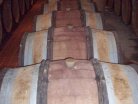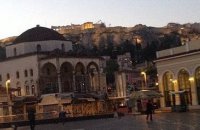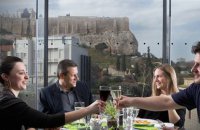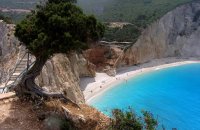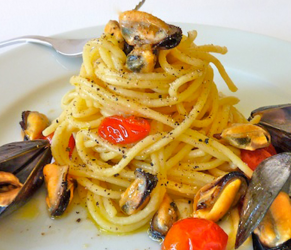The island of Samothraki is one that wins you over on your first visit, enchanting you with the crystal waters of its waterfalls, its lush vegetation, and the imposing Mt Saos. According to Homer, it was from the peak of this mountain that Poseidon spectated the Trojan war.
Built amphitheatrically along the slopes of Mt Saos, lies the Hora. The town looks more like a well-designed theater than an ordinary island capital, with its two-story red-tiled houses and quaint cobble-stone streets. The Church of the Dormition of the Virgin (Koimesis Theotokou) is worth a visit for its valuable icons and the supposed heads of the "Five Martyrs of Samothraki." The ruined medieval Castle, a 1400 remnant of the rule of the Genovese Gatelouzo family, is another must-see. On your way to the castle, stop at one of the many bakeries that makes the traditional "gorgi" rusks and delightful leavened bread.
Continuing south, go up to the church of Panagia Krimniotissa, which, as it clings to the cliffs, offers excellent views of the island’s nicest beach- Pahia Ammos. On your way down, visit the renowned eatery Profitis Ilias and taste some of the wonderful goat on the spit.
To the north of the Hora is Paleopolis, the island’s archaic and Hellenistic center, where you can view ruins of the Ancient City and the Sanctum of the Great Gods. This is where the Cabeiri Mysteries took place, rituals that supposedly aimed to secure life after death. But since the initiated were not allowed to talk about these ceremonies, historians and archaeologists cannot make conclusive claims.
East of Paleopolis is Therma, a small town that becomes very busy in the summers, due to its therapeutic sulfurous springs. From Therma, begin either the hikes to peak Fengari, or the path that leads to Gria Vathra, both of which will offer spectacular views. Be sure to stop by the Vathres, the stunning waterfalls that run from the peak of the mountain, creating small natural pools on the way down, and in turn leading to new waterfalls.
Next, traverse the ravine of Fonias, a gorge that also springs from the peak of the mountain, creating many more waterfalls on its way down. If you are less adventurous, perhaps take a stroll through the riverine forest, redolent of beautiful perennial plane trees and matchwood. Stop by the Medieval Tower, a structure that offers exquisite views of the river.
Since roads do not reach all parts of the island, there are some places that you will need to visit via boat, in order to experience the magnificent beauty. For example, you will need to take a boat to see the waterfall of Kremastos, a cascade that falls into the sea after a 100-meter drop. Similarly, you must travel by water to see the adorable Mediterranean seals that have found their haven in the sea caves of Samothraki. If you get this far, be sure to make it to Vatos, a beach of unique beauty, surrounded by high rocks with caves, and situated a bit to the west.
Eating out:
With its specialty being the goat on the spit, Samothraki is famous for its fine traditional food. The island’s best taverna, “O Vrahos,” is situated on the road to Profitis Ilias. Also, be on the look out for “O Sotiras,” an eatery situated in the forest, just above Hora. There, you will fine exquisite roasted goat and magnificent fried potatoes, in addition to many delectable traditional “mezedes." Instead of a refrigerator, the taverna uses the basin with frozen running water to preserve food. A plethora of tavernas, such as "Akrogialim" on the road to Lakomma, or “Limanaki” on Kamariotissa beach, serve unbelievably tasty seafood.
At Kamariotissa beach is also “Klimataria,” the tavern of Mr. Antonis that has remained open for more than twenty years. On the eastern side of the island, you can visit the delicious “Perivoli tou Ouranou,” at Therma, as well as the eatery of Mrs. Maria, a sweet woman who has converted the lower part of her house into an “ouzadiko.” Ask for her homemade leaven bread, along with the cheese that she produces herself. Predictably, the omelet made from eggs and vegetables from her yard is also divine.
For dessert, definitely go to Hora’s “Aggelonia,” for crepes and loukoumades, but don’t leave if you haven’t tasted the fantastic spoon sweets. The owners are known across the island for their amazing figs, morello, quince, “praousti” (wild prune), and walnuts, all of which are preserved and then sweetened to perfection.
Where to stay:
You will find more rooms for rent than hotels on Samothraki, since, unlike most other Aegean islands, it is not a touristy island. At Kamariotissa, you can find "Aiolos" (2551-41795), and on the road to Paleopolis is the hotel "Kastro" (25510-89400). At Therma, you can stay at "Caveiros" (25510-98278) or at "Mariva" (25510-98230 & 98258), where Mrs. Chryssoula will show you what Samothracian hospitality is all about. If one of them has not opened yet due to the weather, you can find many rooms for rent in Kamariotissa as well as in Hora.
How to get there:
You can get to the island either from Kavala or from Aleksandroupoli, with a ferry or a flying dolphin. There are also routes once a week from Lavrio.
Useful Telephone Numbers:
Municipality of Samothraki - 25510 41584
Health Center - 25510 41217
Police - 25510 41203
Port Authority - 25510 41305
Samothraki Island, Unaffected by Modernity
Stubbornly retaining its natural beauty, Samothraki remains untouched by this modernizing, globalizing day in age.
Country:
Category:
Related Articles
Most Popular recipes







